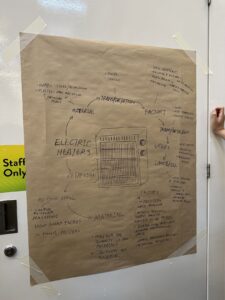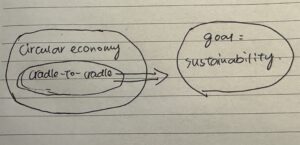This week, we focused on the circular economy. The lecture focused on the relationship between design, society, and the environment, as well as the interactions between production and consumption, labor and resources, and ecological repercussions. In the workshop, we also attempted to connect the production chain, which considerably aided my comprehension of the relationships between these aspects and other models. In the second phase, our group sketched the type energy. We chose electric heaters to develop. At this point, we have a better understanding of the goods complete production chain and have redefined it to be more environmentally friendly.


This week, I would like to discuss the Cradle-to-Cradle model and the circular economy. Because I believe they are very similar, their essential concepts and shared purpose are to achieve sustainable development. However, this begs the question of whether these two models complement or diverge in theory and practice.
The circular economy is an economic framework. It strives to address global concerns such as climate change, biodiversity loss, waste, and pollution and is founded on three principles: waste and pollution elimination, circulating products and materials at their best value, and natural regeneration. These concepts guide the design process (Ellen MacArthur Foundation, 2020). The building material “WasteBasedBricks,” produced by the Dutch business StoneCycling, is an example of this. The bricks are created from construction trash and industrial byproducts.It can be used to decorate both the interior and exterior of buildings. It exhibits the ability to recycle while retaining the product’s basic functioning.



Front® Sustainable Building Materials – WasteBasedBricks (2024) FRONT® Materials. Available at: https://www.front-materials.com/wastebasedbricks/ (Accessed: 01 December 2024)
The circular economy and the Cradle-to-Cradle model have one thing in common: they both oppose traditional design models (cradle-to-grave) and linear economies with the goal of reducing environmental damage caused by humans by minimizing waste, and they both emphasize increasing the reusability of products and materials. And in their plans, designers are the primary driving force behind reaching the objectives.

Caroline Macdonald JP CTB CTE LREA (2022) The shift from linear to circular economy is the road to sustainable digitalization, LinkedIn. Available at: https://www.linkedin.com/pulse/shift-from-linear-circular-economy-road-sustainable-caroline (Accessed: 01 December 2024).

However, I feel that the circular economy is more concerned with the total change of the system. It is a broader macroeconomic framework that includes many aspects of social and economic systems. Cradle-to-Cradle is a design process and concept that focuses on the product itself and how it can remove all waste. So, I believe Cradle-to-Cradle can be considered a component of the circular economy concept, particularly in terms of product design and material utilization. However, there are still variances between them. For example, the circular economy is more adaptable; it allows for the recycling and reuse of materials at many levels. However, the Cradle-to-Cradle paradigm equates waste with food.(McDonough, Braungart, 2019). It pursues absolute circulation with tougher requirements and may encounter market constraints.

Challenges in implementing circular economy, FasterCapital. Available at: https://fastercapital.com/topics/challenges-in-implementing-circular-economy.html (Accessed: 01 December 2024).
But in general, the two are more complementary, with their own distinct emphases. Despite the existing differences, and in fact, they also have similar obstacles in implementation. For example, I remember that at the seminar, one of my classmates shared an interesting example. She mentioned that a manufacturer of brewing machines is so high in quality that customers who have bought its products will hardly come back for a second time. This is where their sales become very limited. But at the end of the day, what we all want to agree on is that the two models can complement each other in a variety of areas along the way to a more sustainable future.
Bibliography:
1.Braungart, M. and McDonough, W. (2019) Cradle to cradle: Remaking the way we make things. London: Vintage Classics.
2.Ellen MacArthur Foundation (2020) ‘The business opportunity of a circular economy’, An Introduction to Circular Economy, pp. 397–417. doi:10.1007/978-981-15-8510-4_20.



